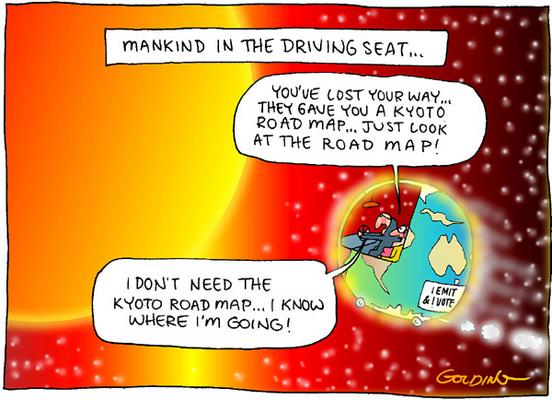|
December 16, 2007
Well something was signed at Bali to reduce greenhouse emissions, but I'm not sure what. I know that Australia is one of the developed countries most at risk from climate change. I also know that the UN negotiations did not go as far as specify any targets for cutting the emissions causing global warming.
But what was actually achieved? Does the deal open the way to real negotiations on effective measures to protect the climate and reduce greenhouse gas emissions? A road map was delivered. Was the Bali meeting a failure, even though it has been declared a success.

Matt Golding
The talks appeared to get somewhere---the world is now committed to launching negotiations that will produce a new global agreement by 2009 to battle climate change---thereby keeping alive hope that we can still get ourselves out of the mess we have created. However, there is still the fact that US obstructionism threatens chances of a post-Kyoto protocol deal by 2009.
The US's intransigence at the Bali conference is no longer accompanied by a denial of the basic science as the US now accepts that the world faces catastrophe. But it still refuses to take its share of the pain needed to avert it. Al Gore was right about the US---it is the United States that is principally responsible for obstructing progress in Bali.
The science that was prepared by the world's top climate experts was relegated to a footnote. The focus on the lowest emission scenario assessed to be able to avoid the most dangerous impacts of climate change-- a two-degree global warming requiring greenhouse gas emissions to be stabilised in the next 10 to 15 years---seems to have been lost. The language of the road map reduced emissions reduction targets to "guidelines. Still the crucial figures - the emissions reduction range of 25-40 per cent by 2020 for industrialised countries - remain.
The US's efforts to forge a deal outside the UN are likely to go nowhere as many in Europe and the developing world decide to wait out the Republican White House and target their efforts towards the Democrats. So the US had little option other than to agree to support the Bali roadmap for a future climate change deal - a successor to the Kyoto protocol.
Update: 17 December
The industrialised countries, including Australia, are doing too little now to actually reduce emissions. Global emissions are still rising, not falling, now. Bali was a small step in the right direction. Thus we have this interpretation of the Bali road map to 2009:

Alan Moir
The road map means that Australia, like the other developed countries, will work towards their national targets with a Garnaut-like process. The road map says that developing countries do not need to commit to quantified targets, but will be required to take measurable and verifiable actions that are "in the context of sustainable development, supported by technology and enabled by financing and capacity-building". Thus developing nations have recognised the need to tackle climate change and, unlike the Kyoto Protocol, will now be part of the next global pact.
Although Bali fell well short of what was required, the next two years remain critical. The next talks take place in Copenhagen in 2008. Even a deal on emissions in 2009 would not in itself mean that action will be taken. It would only impose a duty on countries, which many will ignore, if the example of Kyoto is repeated. Until the developed world cuts emissions in a manner that will change the way people live, there is little prospect of the developing world following suit.
|
